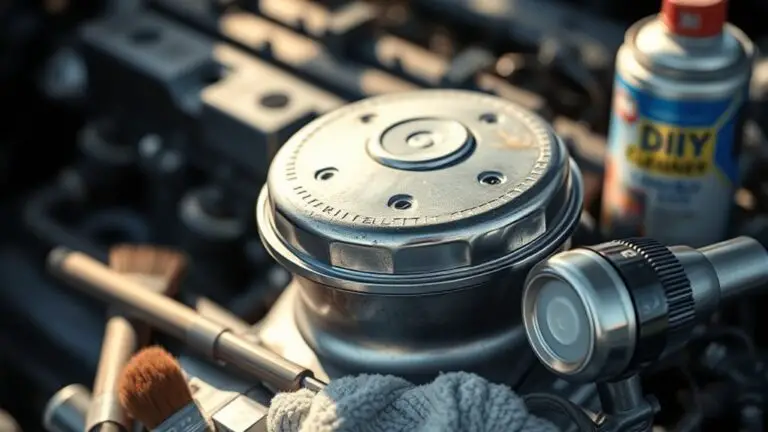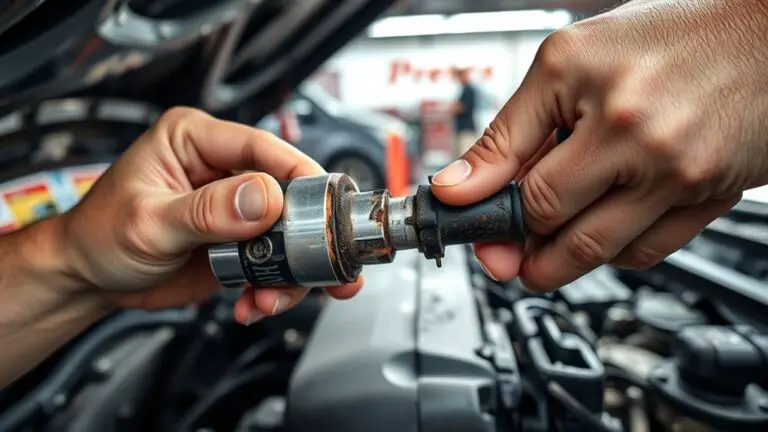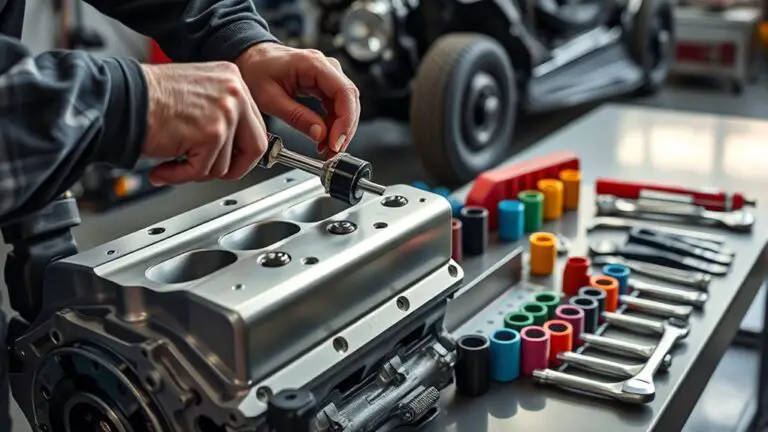How to Check Transmission Fluid and Interpret Results
To check your transmission fluid, start by locating the dipstick while the engine is warm and idling. Pull the dipstick out, clean it, and reinsert it to get an accurate reading. Assess the fluid’s color and smell—bright red and a sweet scent indicate good condition, while dark or burnt fluid suggests problems. Look for contaminants too. Regular inspections can prevent major issues, and there’s more to learn about keeping your transmission healthy.
Understanding Transmission Fluid

Transmission fluid is essential for your vehicle’s performance, serving as both a lubricant and a coolant for the transmission system. Understanding the various transmission fluid types is vital for maintaining ideal function. There are mainly two categories: automatic and manual transmission fluids. Automatic fluids typically contain additives that enhance performance and protect against wear, while manual fluids often focus on providing better viscosity and friction control.
The primary transmission fluid functions include reducing friction between moving parts, dissipating heat generated during operation, and enabling hydraulic pressure for gear shifts. Additionally, it helps to clean and protect the internal components from rust and deposits. Using the correct type of fluid not only enhances your vehicle’s efficiency but also extends the lifespan of the transmission system. By comprehending these aspects, you empower yourself to make informed decisions about your vehicle’s maintenance, ensuring freedom on the road.
Importance of Checking Transmission Fluid
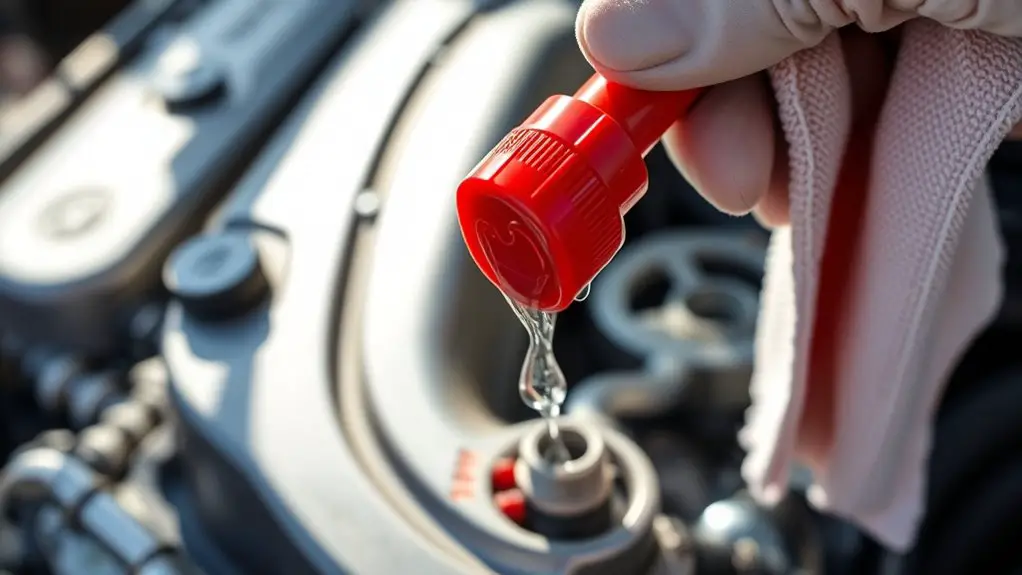
While many drivers may overlook it, regularly checking your transmission fluid is essential for maintaining your vehicle’s overall health. The importance of regularity in this task cannot be overstated. Transmission fluid serves several important functions, including lubrication, cooling, and facilitating smooth gear shifts. Without adequate fluid levels, you risk overheating and damaging your transmission, leading to costly repairs.
Understanding transmission fluid significance means realizing that dirty or low fluid can lead to poor vehicle performance. Regular checks help you identify potential issues early, allowing you to address them before they escalate. By ensuring your transmission fluid is clean and at the proper level, you’ll enhance your vehicle’s efficiency, prolong its lifespan, and ultimately enjoy a more reliable driving experience.
Taking control of this aspect of vehicle maintenance empowers you, allowing you to drive with confidence. So don’t skip this essential step—your freedom on the road depends on it.
Tools You’ll Need
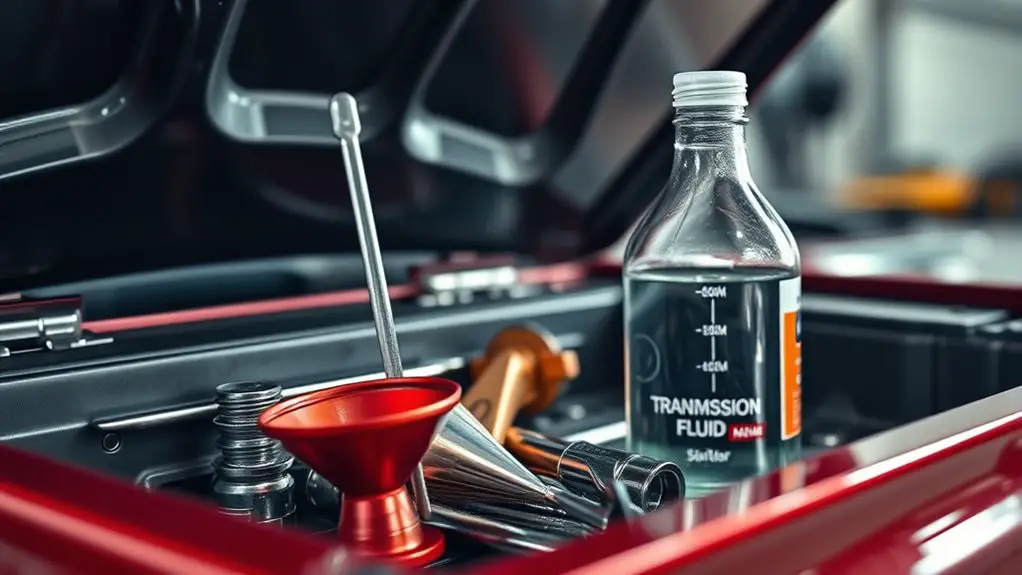
To check your transmission fluid effectively, you’ll need a few essential tools. A dipstick, a funnel, and a clean cloth are vital for accurate measurement and maintenance. Additionally, don’t forget to wear safety gear, such as gloves and goggles, to protect yourself during the process.
Essential Tools Required
When checking your vehicle’s transmission fluid, having the right tools on hand is vital for an efficient process. Start with a clean funnel to prevent contamination when adding fluid. A dipstick is essential for evaluating fluid levels and condition; make sure yours is specific to your vehicle model. For thorough analysis, consider a fluid analysis kit to identify common fluid contaminants such as metal shavings or discoloration, which can signal underlying issues. A flashlight can help illuminate the dipstick and fluid’s clarity, making it easier to spot abnormalities. Finally, a torque wrench may be needed if you’re dealing with a pan removal, guaranteeing proper reinstallation. With these tools, you’re set for an effective transmission fluid check.
Safety Gear Considerations
Before diving into the process of checking your transmission fluid, it’s crucial to prioritize safety by donning appropriate gear. Start with a pair of safety gloves to protect your hands from sharp objects, hot components, or any hazardous fluids that may spill during the process. These gloves guarantee that you maintain a firm grip while working, enhancing your control. Additionally, wear protective eyewear to shield your eyes from potential splashes or debris. This is particularly important since transmission fluid can be irritating if it contacts your eyes. By equipping yourself with safety gloves and protective eyewear, you’re not just following best practices; you’re empowering yourself to work confidently and efficiently while minimizing risks.
Locating the Transmission Dipstick
To locate the transmission dipstick, you’ll first need to identify your vehicle’s make and model, as dipstick placement can vary considerably. Many vehicles have a dipstick accessible from the engine bay, while others may require you to lift the vehicle for access. Knowing these details can streamline the process and guarantee you find it quickly.
Vehicle Make and Model
Locating the transmission dipstick can vary considerably depending on your vehicle’s make and model. Generally, you’ll find it near the back of the engine bay, but some manufacturers may place it in less accessible areas. Check your owner’s manual for specific transmission specifications and dipstick location details tailored to your vehicle. Understanding the recommended fluid types is also essential, as using the wrong transmission fluid can lead to serious issues. Some modern vehicles lack a traditional dipstick altogether, relying on sealed systems, which complicates checking fluid levels. Knowing your vehicle’s unique design empowers you to maintain its transmission effectively, ensuring smooth operation and longevity. Always consult manufacturer guidelines for the best practices.
Dipstick Access Methods
Finding the transmission dipstick can be straightforward if you know where to look. Start by consulting your vehicle’s owner manual; it often details dipstick location methods specific to your make and model. Typically, the dipstick is located near the back of the engine bay, often near the firewall. If you can’t find it, consider using alternative dipstick tools, such as a flexible dipstick or a transmission fluid level gauge. These tools can help you assess fluid levels even in tight spaces. Remember, some newer vehicles may not have a dipstick at all; instead, they might use a sealed system requiring special equipment for fluid checks. Always prioritize safety and consult a professional if unsure.
Preparing Your Vehicle
Before you check your transmission fluid, make certain your vehicle is parked on a level surface and the engine is warm. This guarantees an accurate reading during your fluid inspection. Begin by engaging the parking brake to secure your vehicle, allowing you to work safely. If you’ve recently driven, let the engine idle for a few minutes; this circulates the fluid, providing a more precise measurement.
While waiting, gather your tools: a clean rag or paper towel and possibly a funnel, depending on your vehicle’s design. It’s important to check the owner’s manual for specific transmission fluid requirements, as different systems may have unique procedures. Remember, proper vehicle maintenance not only prolongs the life of your transmission but also enhances overall performance. By preparing correctly, you set the stage for an efficient and effective fluid check, empowering you to take charge of your vehicle’s health.
Checking the Fluid Level
To check the fluid level, start by locating the transmission dipstick, which is typically marked with a brightly colored handle. Before you pull it out, verify the vehicle is running and at normal operating temperature; this is essential as fluid temperature affects the readings. Once you’ve removed the dipstick, wipe it clean with a lint-free cloth, then reinsert it fully and remove it again to check the level.
Look closely at the dipstick markings. There should be indicators for “Full” and “Add,” which reflect the appropriate fluid level. If the fluid sits below the “Add” mark, you’ll need to add fluid. If it’s above the “Full” mark, it may indicate overfilling, which can cause serious transmission issues. Always refer to your owner’s manual for the specific fluid type and capacity.
Assessing the Fluid Color and Clarity
The color and clarity of your transmission fluid are critical indicators of its health. Fresh transmission fluid typically appears translucent, with a bright red hue, indicating proper fluid viscosity. As the fluid ages, you might notice color variations, such as a darker red or brown, signaling oxidation and potential degradation. If the fluid appears muddy or contains particles, this could suggest contamination or internal wear, which may compromise the performance of your transmission.
It’s essential to assess not just the color but also the clarity of the fluid. Clear fluid suggests it’s functioning well, while cloudy fluid points to possible issues that could hinder smooth gear shifts. Regularly checking the fluid’s condition allows you to catch potential problems early, maintaining the freedom of reliable vehicle performance. Keep an eye on these visual cues, and you’ll make informed decisions about your transmission’s health.
Smelling for Unusual Odors
When checking your transmission fluid, pay attention to any unusual odors that may indicate issues. A burnt smell suggests overheating, while a sweet odor could mean coolant contamination. Additionally, a sour scent may point to fluid degradation, requiring immediate investigation.
Identifying Burnt Smell
If you notice an unusual burnt smell while checking your transmission fluid, it could indicate a serious issue. This burnt odor typically signals fluid degradation, which may compromise your transmission’s performance. Ignoring this can lead to costly repairs down the road.
| Symptoms | Causes | Actions |
|---|---|---|
| Burnt odor | Overheating | Check fluid level |
| Dark or black fluid | Fluid breakdown | Change fluid and filter |
| Slipping gears | Insufficient lubrication | Inspect transmission |
| Erratic shifting | Contaminants present | Consult a professional |
Regularly checking for these signs can help you maintain your vehicle’s health and guarantee a smooth driving experience. Don’t take a burnt smell lightly; it’s a warning sign.
Recognizing Sweet Odors
While checking your transmission fluid, you might encounter a sweet, syrupy smell that warrants immediate attention. This odor often indicates a potential coolant leak, which can lead to serious transmission issues if not addressed. During your fluid analysis, any sweet smells should raise a red flag. It’s essential to differentiate between normal transmission fluid odors and those that suggest contamination. If you detect this sweet scent, inspect the cooling system and hoses for leaks, as coolant can mix with the transmission fluid, compromising its effectiveness. Ignoring these signs could result in costly repairs down the line. Always prioritize addressing unusual odors to maintain your vehicle’s performance and longevity.
Detecting Sour Scents
Detecting sour scents during your transmission fluid check can signal significant problems within your vehicle. Sour scent detection often indicates that your fluid is overheating or has become contaminated. Understanding the implications of these odors is essential for maintaining your vehicle’s performance.
- Burnt odor: Indicates overheating, necessitating immediate inspection.
- Acidic smell: Suggests fluid breakdown, leading to possible transmission damage.
- Foul odor: Can signify contamination with engine oil or other fluids.
- Chemical scent: May indicate a coolant leak, requiring urgent attention.
Understanding Fluid Consistency
Transmission fluid consistency is an essential factor in maintaining the health of your vehicle’s transmission system. You need to monitor fluid thickness and understand how viscosity changes can affect performance. Thicker fluid may indicate contamination or degradation, while thinner fluid might suggest leaks or excessive heat.
Here’s a quick reference table to help you understand different fluid consistencies:
| Fluid Condition | Interpretation |
|---|---|
| Thick and Sludgy | Contaminated or degraded fluid |
| Thin and Watery | Possible leaks or overheating |
| Smooth and Red | Healthy fluid, ideal viscosity |
Identifying Common Issues
Identifying common issues with your vehicle’s transmission fluid can prevent more significant problems down the line. When you check your transmission fluid, keep an eye out for these signs that something might be amiss:
- Fluid leaks: Spotting puddles or wet spots under your vehicle is a red flag.
- Unusual noises: Pay attention to any grinding, whining, or clunking sounds while driving, which may indicate transmission issues.
- Discolored fluid: Healthy transmission fluid should be a clear red color; dark or burnt fluid suggests contamination.
- Erratic shifting: If your vehicle shifts gears abruptly or hesitates, it could signal underlying transmission problems.
When to Change Your Transmission Fluid
Noticing issues like discolored fluid or erratic shifting can indicate it’s time to assess your transmission fluid levels and condition. Regular checks are essential for ensuring peak performance and longevity of your vehicle. Refer to your owner’s manual for specific transmission maintenance schedules; these often provide guidelines on when to conduct fluid checks and changes.
Typically, fluid replacement intervals range from every 30,000 to 60,000 miles, depending on your vehicle’s make and model. If you frequently drive in harsh conditions, such as towing or stop-and-go traffic, you might need to change the fluid sooner. Additionally, if you detect burnt odors or metallic particles in the fluid, it’s critical to act promptly. Keeping an eye on these factors not only maintains your vehicle’s efficiency but also gives you the freedom to drive confidently, knowing your transmission is in good shape.
DIY vs. Professional Fluid Check
While you might feel confident checking your transmission fluid yourself, understanding the pros and cons of DIY versus professional inspections is essential. DIY techniques can empower you, offering a sense of freedom, but they also come with risks if not performed correctly. On the other hand, professional services guarantee expertise and thoroughness but may come at a higher cost.
Here are some key considerations:
- Cost-Effective: DIY checks save you money but require proper tools and knowledge.
- Expertise: Professionals often catch issues you might overlook.
- Time-Consuming: DIY methods can take longer, especially if you’re unfamiliar with the process.
- Equipment Access: Professionals have specialized tools that may not be available to you.
Ultimately, weighing these factors can help you decide whether to embrace the DIY spirit or rely on professional services for your transmission fluid checks.
Tips for Maintaining Healthy Transmission Fluid
To guarantee your transmission fluid remains in prime condition, regular maintenance is essential. Start by checking the fluid level monthly; low levels can indicate leaks or other issues. Use quality transmission fluid that meets your vehicle’s specifications, as this guarantees peak performance.
Additionally, consider changing the fluid every 30,000 to 60,000 miles, depending on your driving habits and manufacturer recommendations. This helps remove contaminants that can degrade fluid quality.
Always examine the fluid’s color and smell; a burnt odor or dark color signals the need for immediate attention.
Implement these fluid maintenance tips to keep your transmission healthy: avoid overloading your vehicle, use the correct gear when towing, and shift smoothly.
Frequently Asked Questions
How Often Should I Check My Transmission Fluid?
You should check your transmission fluid every 30,000 to 60,000 miles, or at least annually, to guarantee proper transmission maintenance. Regular checks help you catch potential issues early. If you notice any discoloration or a burnt smell, it’s time for fluid replacement. Staying on top of this not only prolongs your transmission’s lifespan but also gives you the freedom to drive confidently, knowing your vehicle’s performance is optimized.
Can I Mix Different Brands of Transmission Fluid?
You shouldn’t mix different brands of transmission fluid unless they specify compatibility. Transmission fluid compatibility is essential; synthetic and conventional fluids often have different chemical compositions. Mixing them can lead to performance issues or potential damage. Always consult your vehicle’s manual for the recommended type. If you’re unsure, it’s best to stick with one brand and type to guarantee peak transmission health and avoid any complications in the long run.
What Happens if I Overfill My Transmission Fluid?
If you overfill your transmission fluid, it can lead to some rather pesky transmission fluid effects. You might notice overfilling symptoms like foaming fluid, which disrupts proper lubrication and can cause slipping or harsh shifting. Additionally, excessive fluid pressure could damage seals and gaskets, leading to leaks. To keep your ride smooth and carefree, it’s best to maintain the correct fluid level and avoid those troublesome consequences.
Is It Safe to Drive With Low Transmission Fluid?
No, it isn’t safe to drive with low transmission fluid. Insufficient fluid can lead to transmission overheating, slipping, or even complete failure, posing serious risks to your vehicle and safety. You might experience symptoms like delayed shifting, unusual noises, or warning lights. Ignoring these signs can result in costly repairs and compromised driving safety. Always prioritize maintaining proper fluid levels to guarantee your vehicle operates smoothly and you enjoy your freedom on the road.
Can I Check Transmission Fluid Without a Dipstick?
You can check transmission fluid without a dipstick, but it’s a bit tricky. Some vehicles come with sealed transmissions, so you’ll need dipstick alternatives like a fluid level plug. To do this, locate the plug, remove it, and see if fluid drips out; if it doesn’t, you might be low. Just remember, it’s essential to maintain proper levels for ideal vehicle performance, ensuring your freedom on the road isn’t compromised.


